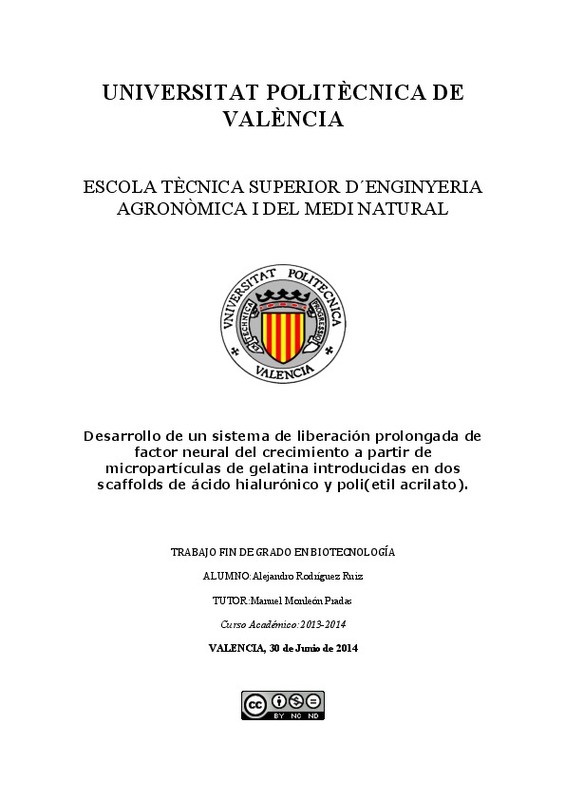|
Resumen:
|
[EN] Nowadays
there
are
lots
of
diseases
with
a
neurologic
origin
where
the
pathogenic
common
marker
is
the
loss
of
specific
groups
of
neurons,
for
example;
Parkinson
disease
with
the
degener ...[+]
[EN] Nowadays
there
are
lots
of
diseases
with
a
neurologic
origin
where
the
pathogenic
common
marker
is
the
loss
of
specific
groups
of
neurons,
for
example;
Parkinson
disease
with
the
degeneration
of
nigral
dopaminergic
neurons;
in
Alzheimer
disease
the
loss
of
septohippocampal,
serotonergic
and
cortical
neurons;
in
the
Huntington
disease
the
death
of
gabaergic
neurons.
Lots
of
these
diseases
have
no
cure
and
there
are
proposed
only
some
alternatives
for
the
reducing
its
effects.
Because
of
this,
tissue
engineering,
one
of
the
most
emerging
parts
in
biomedical
regeneration
will
try
to
solve
these
difficulties
and
create
a
system
that
eliminates
this
problem
from
its
base.
In
this
way,
in
this
study
it
is
proposed
the
idea
of
a
continue
release
of
a
neurologic
growth
factor
(NGF),
a
protein
that
allows
the
growth
and
maintenance
of
some
groups
of
neurons
preventing
its
atrophy
and
death
of
these
neurons
when
some
kind
of
injury
is
produced.
For
this
reason
in
this
article
it
is
proposed
the
insertion
of
the
NGF
in
microspheres
of
gelatin
whose
degradation
will
produce
a
releasement
of
the
factor
during
the
first
most
critical
hours
of
the
process
promoting
the
neural
growth.
The
main
problem that
these
kind
of
microspheres
have,
its
is
wide
dispersion
in
the
body
,
needing
some
kind
of
structure
that
maintains
them
fixed
in
the
wished
place.
To
solve
this,
it
surged
the
idea
of
inserting
these
microparticles
in
a
structure
called
scaffold.
These
scaffolds
will
maintain
the
microspheres
in
its
structures
and
will
allow
them
to
degrade
in
the
desired
placed.
The
election
of
the
three-‐dimensional
scaffold
will
also
be
conclusive
for
the
insertion
of
the
microspheres,
considering
different
variables
such
as
the
size
of
the
porous,
its
resistance
to
mechanical
efforts
and
its
degradation
rate.
Because
of
these
reasons
two
very
different
materials
will
be
compared:
the
hyaluronic
acid
a
natural
biopolymer
that
can
be
found
in
the
extracellular
matrix
of
the
organism;
and
the
poly(etyl
acrylate)
a
very
resistant
acrylic
polymer.
Also,
another
of
the
more
important
topics
will
be
the
loading
of
the
neural
growth
factor
using
for
this
a
model
protein
that
will
allow
us
to
know
the
kinetics
of
the
releasement
of
the
microspheres.
Finally
as
these
materials
will
be
implanted
in
the
organism,
it
will
be
necessary
to
prove
the
cytotoxicity
of
them,
and
make
cell
in
vitro
cultures
to
prove
that
the
desired
effect
of
the
study
is
done.
[-]
[ES] En
la
actualidad
existen
gran
cantidad
de
enfermedades
de
tipo
neurológico,
donde
el
marcador
patológico
común
es
la
pérdida
de
grupos
de
neuronas
específicas,
por
ejemplo:
en
la
enfermed ...[+]
[ES] En
la
actualidad
existen
gran
cantidad
de
enfermedades
de
tipo
neurológico,
donde
el
marcador
patológico
común
es
la
pérdida
de
grupos
de
neuronas
específicas,
por
ejemplo:
en
la
enfermedad
de
Parkinson
es
clave
la
degeneración
de
las
neuronas
dopaminérgicas
nigrales;
en
la
enfermedad
de
Alzheimer,
lo
es
la
pérdida
degenerativa
de
neuronas
septohipocampales,
serotoninérgicas
y
corticales,
y
en
la
enfermedad
de
Huntington,
la
muerte
de
las
neuronas
gabaérgicas
de
proyección
del
estriado.
Muchas
de
estas
enfermedades
carecen
de
cura,
y
sólo
hay
propuestas
distintas
alternativas
para
la
disminución
o
reducción
de
sus
efectos.
Por
ello,
la
ingeniería
tisular,
una
de
las
ramas
más
emergentes
de
la
regeneración
biomédica,
tratará
de
solventar
dichas
dificultades,
y
llegar
a
la
creación
de
un
sistema
que
elimine
dicho
problema
desde
su
base.
De
este
modo,
en
este
estudio
se
contempla
la
idea
de
la
liberación
continuada
de
un
factor
de
crecimiento,
el
factor
de
crecimiento
neuronal
(NGF),
una
proteína
que
permite
el
crecimiento
y
mantenimiento
de
ciertos
tipos
de
neuronas,
impidiendo
de
ese
modo
el
atrofiamiento
y
muerte
de
éstas
cuando
se
produce
algún
tipo
de
lesión.
Para
ello
se
propone
su
introducción
en
micropartículas
de
gelatina,
cuya
degradación
continuada
provocará
una
liberación
de
NGF
durante
las
primeras
horas
más
críticas
a
lo
largo
del
tiempo
y
promoverá
el
crecimiento
neuronal.
El
principal
problema
que
se
da
con
este
tipo
de
micropartículas
es
su
gran
dispersión
necesitando
de
algún
tipo
de
estructura
que
las
mantenga
fijadas
en
la
estructura
deseada.
Así
pues,
en
este
trabajo
se
plantea
la
idea
de
la
introducción
de
dichas
microesferas
en
distintos
soportes
tridimensionales
o
scaffolds.
Estos
soportes
se
encargarán
de
atrapar
las
microesferas
en
su
estructura,
y
conforme
éstas
se
degraden,
irán
liberando
en
la
zona
deseada
el
NGF.
La
elección
del
soporte
tridimensional
también
será
decisiva
para
la
introducción
de
las
micropartículas,
considerándose
distintas
variables
como
son
el
tamaño
de
los
poros,
su
resistencia,
y
su
tiempo
de
degradación.
Por
ello
en
este
estudio
se
compararán
dos
materiales
de
naturaleza
muy
distinta:
el
ácido
hialurónico,
un
biopolímero
natural
que
se
encuentra
en
la
matriz
extracelular
del
organismo;
y
el
poli(etil
acrilato)
un
polímero
acrílico
de
gran
resistencia.
Otro
de
los
temas
de
mayor
importancia
será
la
carga
del
NGF
utilizando
una
proteína
modelo
llamada
BSA
que
permitirá
conocer
la
cinética
de
liberación
de
las
micropartículas.
Finalmente,
también
es
necesario
comprobar
la
citotoxicidad
de
los
distintos
materiales
empleados,
debido
a
que
deberán
implantarse
en
el
organismo,
así
como
la
realización
de
cultivos
celulares
in
vitro
para
la
comprobación
de
que
se
está
consiguiendo
el
objetivo
deseado.
[-]
|







